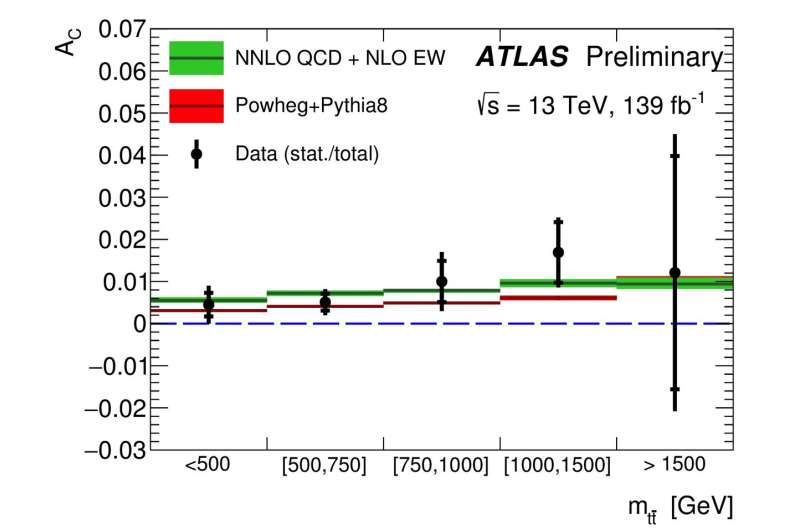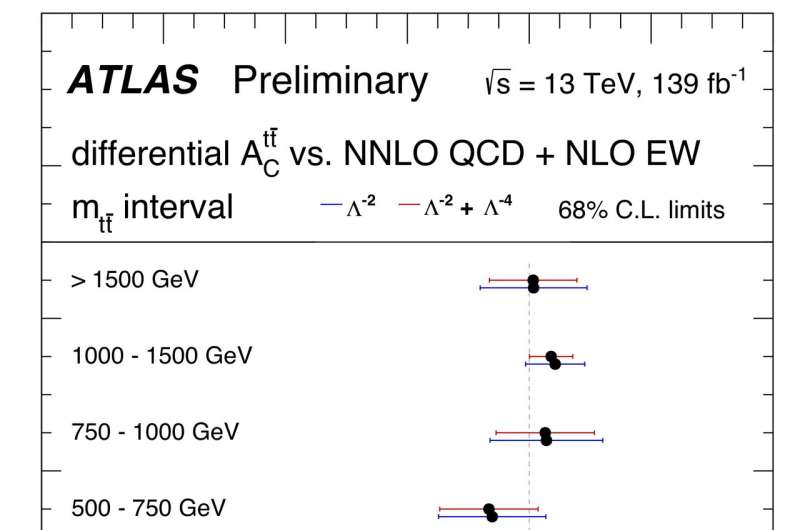ATLAS Experiment finds evidence of charge asymmetry in top-quark pairs

Among the most intriguing particles studied by the ATLAS Experiment is the top quark. As the heaviest known fundamental particle, it plays a unique role in the Standard Model of particle physics, and perhaps in physics beyond the Standard Model.
During Run 2 of the Large Hadron Collider (LHC) at CERN, proton beams were collided with high luminosity at a centre-of-mass energy of 13 TeV. This allowed ATLAS to detect and measure an unprecedented number of events involving top-antitop quark pairs, providing ATLAS physicists with a unique opportunity to gain insight into the top quark's properties.
Due to sneaky interference between particles involved in the production, top and antitop quarks are not produced equally with respect to the proton beam direction in the ATLAS detector. Instead, top quarks are produced preferentially in the centre of the LHC's collisions, while antitop quarks are produced preferentially at larger angles. This is known as a "charge asymmetry."
Charge asymmetry is similar to a phenomenon measured at the Tevatron collider at Fermilab, known as a "forward-backward" asymmetry. At Tevatron, colliding beams were made of protons and anti-protons, respectively, which led to top and antitop quarks each being produced at non-central angles, but in opposite directions. A forward-backward asymmetry, compatible with improved Standard Model predictions, was observed.

The effect of charge asymmetry at the LHC is predicted to be extremely small (< 1%), as the dominant production mode of top-quark pairs via the scattering of gluons (the carriers of the strong force) emerging from the protons does not exhibit a charge asymmetry. A residual asymmetry can only be generated by more complicated scattering processes involving also quarks. However, new physics processes interfering with the known production modes can lead to much larger (or even smaller) values. Therefore, a precision measurement of the charge asymmetry is a stringent test of the Standard Model. It is among the most subtle, difficult, and yet important properties to measure in the study of top quarks.
A new ATLAS result, presented this week at the European Physical Society Conference on High-Energy Physics (EPS-HEP) in Ghent, Belgium, examines the full Run 2 dataset to measure top-antitop production in a channel where one top quark decays to one charged lepton, a neutrino and one hadronic "jet" (a spray of hadrons); and the other decays to three hadronic jets. The analysis fully includes events where the hadronic jets are merged together (so-called "boosted topology").
ATLAS finds evidence of charge asymmetry in top-quark pair events, with a significance of four standard deviations. The measured charge asymmetry of 0.0060 ± 0.0015 (stat+syst.) is compatible with the latest Standard Model prediction, and the measurement confidently states that the observed asymmetry is non-zero. It is the first ATLAS top physics measurement to utilize the full Run 2 dataset.
The new ATLAS result marks a very important milestone following decades of measurements. Figure 1 shows that the dataset allows ATLAS to measure the charge asymmetry as a function of the mass of the top-antitop system. Figure 2 shows the resulting bounds on anomalous effective field theory (EFT) couplings that parametrize effects from new physics which would be beyond the reach of being directly produced at the LHC.
This new result is yet another demonstration of ATLAS' ability to study subtle Standard Model effects with great precision. The observed agreement with Standard Model predictions provides one more piece to the puzzle in our understanding of particle physics at the energy frontier.
More information: Inclusive and differential measurement of the charge asymmetry in tt¯ events at 13 TeV with the ATLAS detector (ATLAS-CONF-2019-026): atlas.web.cern.ch/Atlas/GROUPS … ATLAS-CONF-2019-026/
Provided by ATLAS Experiment





















